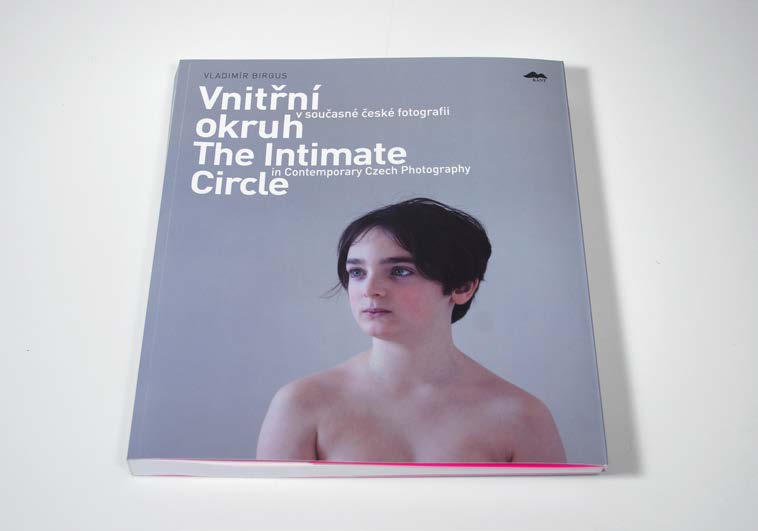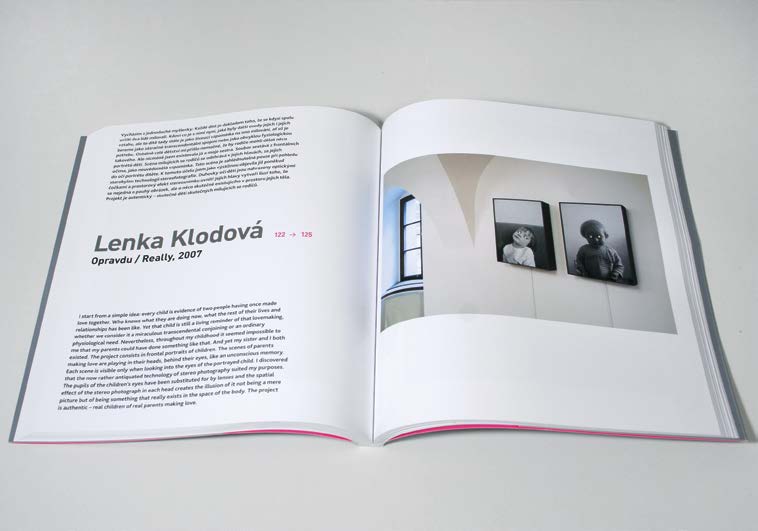Intimacy and Inner Life in Czech Photography of the Last 13 Years
The Intimate Circle in Contemporary Czech Photography (Vnitřní okruh v současné české fotografii) is a catalogue accompanying the eponymous exhibition at City Gallery Prague (June–August 2013), with reprises at the Month of Photography in Bratislava, and the Museum of Art in Olomouc.
Brought out by Kant Publishers, it has the form of a traditional photography book, with elegant and clearly structured graphic design by Vladimír Vimr. Each artist is allotted ample space, allowing for a sufficiently representative selection of the groups of items on exhibition, complete with artist statements, which also form an organic part of the exhibition concept. These testimonies by artists help to introduce and elucidate the work presented, and in some cases serve as an autonomous component of the resultant works themselves. In the context of art which reflects motifs of self-contemplation and intimate experience, these clues, or intimations, make the body of work more accessible and communicable.
After the Mutating Medium project (Rudolfinum Gallery, 2011), The Intimate Circle – both exhibition and book – represent a major effort with the ambition of showcasing the most contemporary tendencies in the Czech photography scene. Vladimír Birgus, curator and author of the catalogue, conceived this retrospective as thematic in nature, with a focus on self-contemplative approaches in photography, expressed through subject matter preoccupied with the most immediate and intimate habitat of the artist. These tendencies indeed form a distinctly contemporary phenomenon, particularly if one takes into regard the photographic output of the previous decades (more precisely, the period before 1990). In this way the book could have done with a more comprehensive essay, placing this shift in a broader historical and theoretical context, as well as considering issues such as the popularity of the form of diary record and the interpretation of family albums that have become much-frequented artistic strategies among the youngest generation; it might also have defined what distinguishes these strategies as they are employed in the works on exhibition. Related to this is the use of the amateur approach to the photographic medium and the phenomenon of photographs taken with mobile phones. These essential shifts are only briefly touched upon in the introductory text by Vladimír Birgus.
The selection of artists and works nonetheless enables the pinpointing of the defining traits of the inner circle – the innermost experience of oneself and one’s intimate surroundings. Within the selection on display, these include above all a preoccupation with partnership and family – the most intimate human relationships. Spouses, both real and fictitious, lovers, relationships on the rocks, children, siblings and parents, all primarily rendered in the form of portraiture and subjective or fictitious documentary. Intimate experience is also represented by approaches based upon self-contemplation – the self-portrait, and the reconstruction of memories, mainly of childhood or past relationships. It is curious in this respect that the subject of friendship is broached solely in the work of Libor Fojtík.
According to this selection, contemporary Czech artists are relatively little concerned with sexuality as such, an open-minded take on sexuality, their most intimate lives, not to mention homosexuality or sexual otherness. Among the artists on exhibition, these themes are addressed mainly by Daniel Poláček (though more in the role of a voyeur), Tereza Kabůrková, Lenka Klodová, Vladimír Kiva Novotný and Petra Steinerová. Sombre themes, concerning the less happy aspects of human life, such as illness, physical decay, or death, appear merely as glimpses within the current selection, represented by the work of Jiřina Hankeová, Míla Preslová, Libuše Jarcovjáková, Milena Dopitová, Ivan Pinkava and Jiří Šigut, and partly also in the work of Pavel Mára and Petr Willert.
What is absent entirely is the subject of religious faith and religious experience – an innermost human experience, or rather, part of the human experience. This absence may simply be a significant testimony regarding the context of the space and time we inhabit. Neither the installation of the exhibition, nor the structure of the works in the book, however, reflect the above-cited issues as part of the theme-based sections; each group of works is given ample space, but presented rather in their own right. They do not communicate within a single room, yet by default they enter into a conversation. While this is not a problem within the book concept, in the separate exhibition rooms the viewer may start to wonder about the “story” of the exhibition.
In most cases, the selected groups of work fall into the above-defined categories of theme, complying with received notions of intimate experience. These clear and easily defined motifs are assaulted with an electrifying and unsettling charge only by the testimonies of Ivan Pinkava and Johana Pošová, which go beyond this delineated framework. Work which goes beyond these limits is exemplified also by Michal Kalhous’s Rýč, míč, klíč – absent from both the book and the exhibition – reflecting his fresh experience as a husband and new father against the backdrop of a domestic setting. A viable contribution regarding the issues of relationships between generations, and ultimately the portrayal of old age, might have been represented by Kamila Musilová’s compelling cycle Dědeček a babička / Grandpa and Grandma. Peter Fabo’s long-term relationship is rendered in a very interesting photographic form in his cycle Diana. Adam Holý might have presented a contribution to the discussion of the unique inner worlds of contemporary artists through his unsettling open and intimate confessional work. Perhaps these might have been a more constructive contribution than the inclusion of new variations on the visual cliches of Pavla Ortová, Magda Veselá, Veronika Šrek Bromová, or the duo of Juliana Křížová & Jakub Vlček.
#22 Image and text
Archive
- #45 hypertension
- #44 empathy
- #43 collecting
- #42 food
- #41 postdigital photography
- #40 earthlings
- #39 delight, pain
- #38 death, when you think about it
- #37 uneven ground
- #36 new utopias
- #35 living with humans
- #34 archaeology of euphoria
- #33 investigation
- #32 Non-work
- #31 Body
- #30 Eye In The Sky
- #29 Contemplation
- #28 Cultura / Natura
- #27 Cars
- #26 Documentary Strategies
- #25 Popular Music
- #24 Seeing Is Believing
- #23 Artificial Worlds
- #22 Image and Text
- #21 On Photography
- #20 Public Art
- #19 Film
- #18 80'
- #17 Amateur Photography
- #16 Photography and Painting
- #15 Prague
- #14 Commerce
- #13 Family
- #12 Reconstruction
- #11 Performance
- #10 Eroticon
- #9 Architecture
- #8 Landscape
- #7 New Staged Photography
- #6 The Recycle Image
- #5 Borders Of Documentary
- #4 Intimacy
- #3 Transforming Of Symbol
- #2 Collective Authorship
- #1 Face


